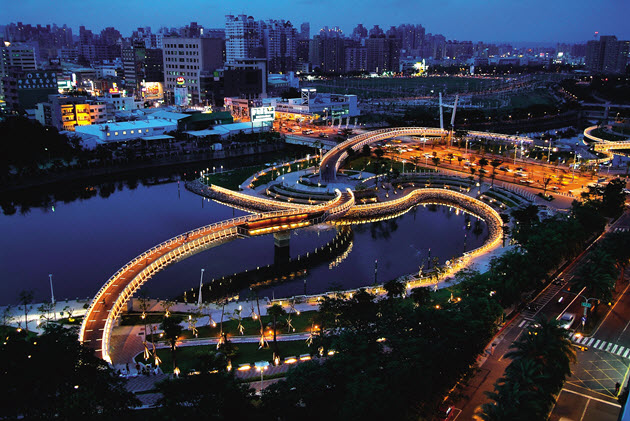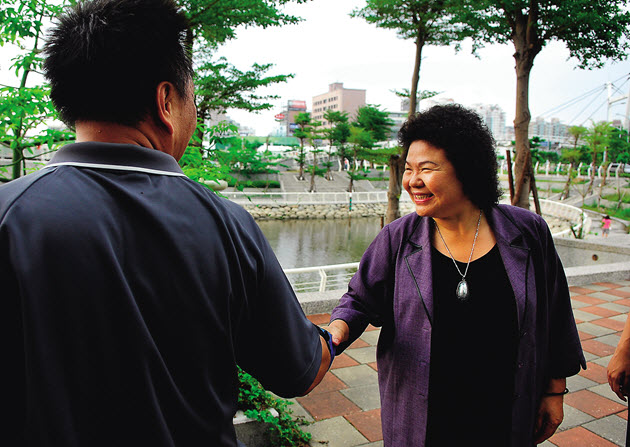Kaohsiung City
From Soot and Smoke to the Sweet Life

Source:CW
How does a city of heavy industry seize the nation’s top environmental ranking? Kaohsiung's revolution in urban aesthetic began 'on the river.'
Views
From Soot and Smoke to the Sweet Life
By Benjamin ChiangFrom CommonWealth Magazine (vol. 430 )
It's just past 9 pm and Kaohsiung's "Heart of Love River" park, caressed by a gentle breeze, seems lovelier as the evening progresses.
"Breathe deeply and slowly extend your left hand," a yoga teacher instructs a dozen or so women who are seated along one of the park's pathways, slowly going through their exercises.
Streaming down the bicycle path along the banks of Love River, the headlamps of hundreds of bicyclists appear as a swarm of fireflies in a thick forest.
"I couldn't even imagine exercising on the banks of Love River before," a Ms. Chen recalls during her riverside evening constitutional.
Over the past three years, Kaohsiung has quietly undergone a space management revolution.
"Kaohsiung used to be like a heavy industrial 'kitchen,' full of soot and oily smoke," Kaohsiung mayor Chen Chu says descriptively.
But in this year's CommonWealth Magazine Competitiveness Survey rankings for cities and counties, Kaohsiung City charged into the number-one spot in the Environmental Protection category and leapt from seventh to second place in the overall national rankings.
Urban Beautification Begins at the River
Any discussion of the beautification of Kaohsiung must necessarily begin with the project to restore Love River.
A river is the arterial pulse of a city. "A river restoration project must restore the life force of the river," insists the mayor. River restoration eliminates water pollutants and inevitably beautifies the city, achieving visible progress.
Love River, Houjing Stream and Cianjhen River all flow on a north-south course through Kaohsiung, and the city government adopted a plan that would simultaneously restore the entire courses of all three.
The first step was to reduce the level of effluent flowing into Love River, so that it was no longer a festering source of stench. Since taking office, Mayor Chen has significantly raised the ratio of household sewage hookups to the city's sewage treatment system from around 30 percent during the administration of former Mayor Frank Hsieh to 53 percent today.
"Improving the sewerage system is not a public infrastructure project that the public can actually see, but we must resolve to forge ahead if we're to change our living environment at its most basic level," Chen insists.
Additionally, the city embarked on a massive tree planting campaign and constructed bike paths and public art spaces along the riverbanks, gradually extending the restoration project into the upstream reaches of the river.
"Next year, with the merger of the city and county governments, the river restoration project will be extended out into Kaohsiung County," Chen says.
To improve living conditions within the city, Chen's government drew up an urban renewal plan encompassing everything from the design of street signs and street lamps to the trees lining pedestrian walkways and the paint schemes of public buildings into an integrated urban aesthetic.
The Kaohsiung City Government's civil engineering corps employed water and greenery as the centerpiece of the urban renewal plan.
"From north to south we mapped out the nation's first network of urban wetland parks and wetland ecological corridors," says Shyh-fang Liu, chairperson of the Kaohsiung City Government's Research, Development and Evaluation Commission. The wetlands ecological corridor stretches like a belt from the north to the south through the narrow, elongated city, allowing flora and fauna to migrate freely and helping to improve air quality.
Battling Developers for Parkland
Another major change in the city has been the increase in green space.
During the past three years, the city government has opened up 766 hectares of parkland green space, the equivalent of 29 Taipei Da-An Forest Parks.
"Kaohsiung residents enjoy twice the per-capita park space as their Taipei counterparts," the mayor says triumphantly.

Opening up all that green space started with restoring disused plots of land around the city. In the past, the city had been dotted with numerous plots of disused public and private land, most surrounded by ugly green sheet metal fences, creating not only a blight on the cityscape but sanitation and public security blind spots.
In response, the city instituted the "Vacant Land Beautification Project," which in effect stated, "The city government will impose heavy fines on owners of vacant land that falls into disrepair," Chen says. To encourage the greening of Kaohsiung, the city offered reductions or exemptions on property taxes as well as an increase on permitted plot ratios to landowners that agreed to beautify their vacant land. In three years the city succeeded in the greening of 230 hectares of previously disused land, greatly increasing the area of green space and parkland in the city.
Building new parks necessarily meant doing battle with real estate developers. The city government took another look at development plans for city land then on the table.
"We are happy to provide land to build parks, not develop commercial districts to make money," Chen says.
Willingly turning its back on a potential NT$15 billion windfall for the city coffers, the city turned the Aozaidi area in northern Kaohsiung, originally zoned for commercial development, into a forest park.
Although on the books the city sacrificed a sizable sum in land development revenue, that has been offset by increased city property tax revenues resulting from the rising value of land adjacent to the park.
Urban planning requires long-term vision and can't be based on considerations of commercial development alone. Adequate environmental protection always ultimately benefits urban development.
"We're trying to make Kaohsiung a more refined place and not just a coarse city of heavy industry," Mayor Chen says of her blueprint for the future of Taiwan's Harbor City.
Translated from the Chinese by Brian Kennedy
Kaohsiung City at a Glance
Land Area: 153.6 sq. km
Population: 1.53 million
Overall Survey Ranking: Second
Environmental Protection Ranking: First
Social Welfare Ranking: Second
Chinese Version: 高雄市 從油煙味到有韻味






